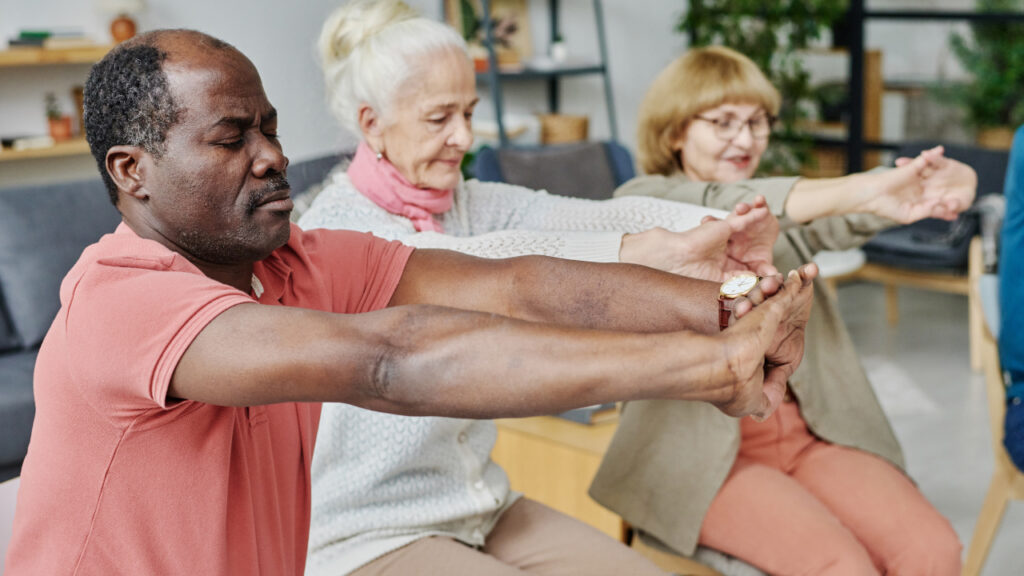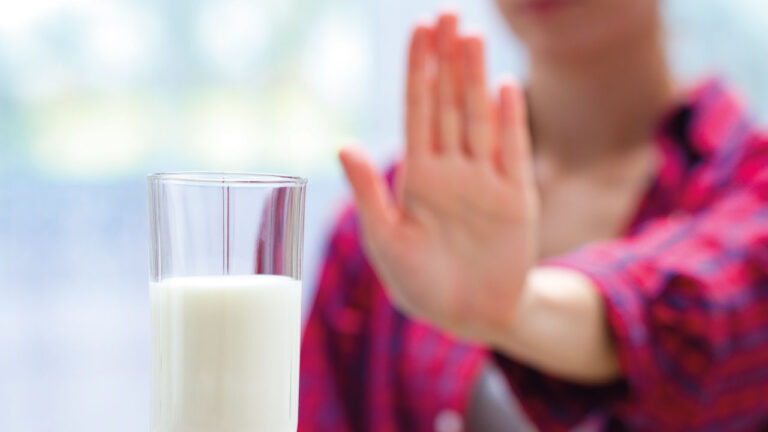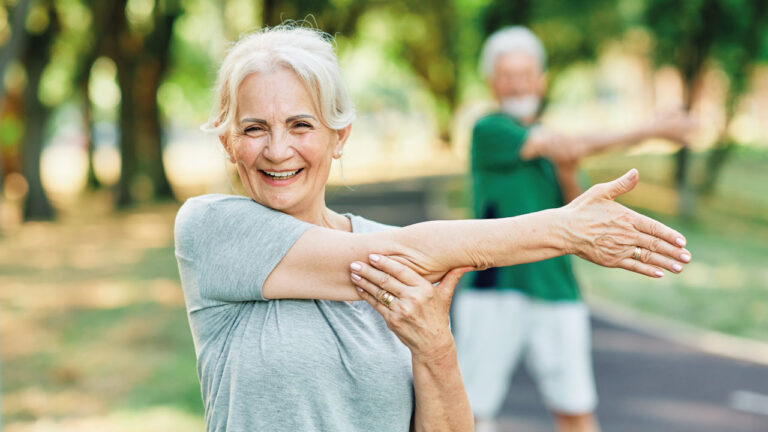There are several simple and safe options to help improve strength, circulation and well-being. In this article, we share safe suggestions for seated exercises, ideal for doing at home or in institutions, and which respect each person’s limits and pace.
Key points of the article
- Physical activity is essential for the elderly, even with reduced mobility, and can be done safely with seated exercises
- These exercises improve circulation, muscle strength, balance and emotional well-being
- The article presents 2 stretches and 5 exercises that are easy to perform with or without accessories
- It includes guidelines on frequency, safety, contraindications and tips for adapting the exercises to the reality of each elderly person.
Why are they important?
Regular physical exercise, even if adapted, can improve circulation, strengthen muscles, relieve joint pain and contribute to the physical and emotional well-being of the elderly. It is necessary to respect the physical needs of each elderly person. Sitting exercises present a low risk of injury and achieve the same results as standing exercises. They also promote autonomy, contribute to well-being and facilitate inclusion.
What kind of chair should I use?
The choice of chair is important for the exercises to be carried out correctly; it should not have wheels and should be comfortable. It is essential that your back is straight and stable.
How often do you practice?
According to the WHO (World Health Organization) , exercise should be done 2-3 times a week, with sessions lasting 20-30 minutes. However, the most important thing is to combat sedentary lifestyles and promote physical exercise. Elderly people should start with small activities and increase the frequency, duration and intensity as much as possible, depending on their specific needs.
List of exercises on the chairs and suggestions on how to practice
Stretching is essential before any physical activity so that there is no risk of injury. They improve blood circulation and warm up the muscles.
We show you two examples of stretches for the elderly:
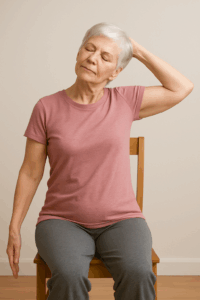
Neck stretching
- Sit with your back straight and your feet flat on the floor
- Slowly tilt your head to the left side
- Keep tilting until you feel a gentle stretch on the right side of your neck
- Still in this position, extend your right arm downwards and slightly to the side
- Hold the stretch for 15 to 20 seconds, and don’t forget to breathe slowly
- Carefully return to the neutral position
- Repeat the exercise on the opposite side (head to right shoulder, left arm extended).
- Finally, you can slowly turn your head in a complete circular motion (360°), calmly and without forcing.
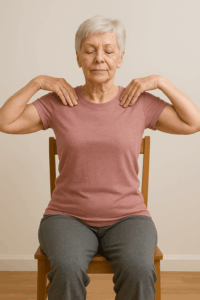
Shoulder circle
- Sit with your back straight and your feet flat on the floor
- Place the fingertips of your hands on your shoulders, with your elbows pointing to the sides.
- Make circles with your elbows forward, moving your shoulders in rotation
- Repeat the movement forward 15 times, slowly and under control
- Then reverse direction: make circles with your elbows backwards
- Repeat the movement 15 times backwards
- Always keep your breathing calm during exercise.
After stretching, here are 5 exercises that work both the upper and lower body:
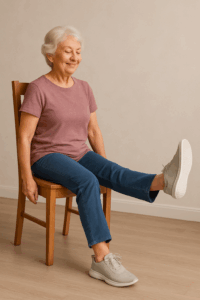
1. alternating leg raises
Helps to strengthen the thighs and improve circulation.
- You must be sitting with your back straight and your feet on the floor
- Stretch one leg forward and hold it there for 3 to 5 seconds
- Return to the starting position and repeat with the other leg
- You should do 10 repetitions with each leg.
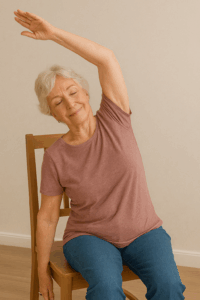
2. Lateral stretching of the trunk
Improves flexibility and helps relieve tension.
- With your feet on the floor, raise your right arm above your head
- Tilt your torso slightly to the left side
- Hold the position for 10 seconds and return to the center
- Repeat with the opposite side. Do 3 times on each side
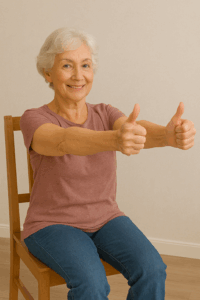
3. Pull your arms back (bring your shoulder blades together)
Strengthens the upper back.
- Stretch your arms out in front of you, with your thumbs pointing upwards
- Pull your elbows back as if to “open your chest”
- Bring the shoulder blades together and hold for 2 seconds
- Stretch your arms out again. Do 10 repetitions.
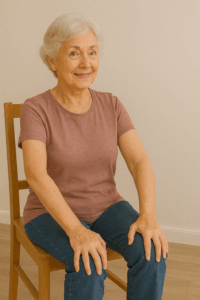
4. Hands on knees
Activate the abdominal area safely.
- Place your hands on your knees and push them together.
- At the same time, push your legs against your hands
- Hold the pressure for 5 seconds and relax
- Repeat 8 to 10 times.
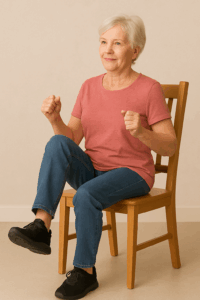
5. March in place (seated version)
Activates circulation and improves coordination.
- Sit with your back straight and lift one knee at a time
- Alternate your legs, as if you were “marching” sitting down
- Maintain the rhythm for 30 seconds to 1 minute
- Rest and repeat 2 or 3 times.
Care before you start
Before the elderly begin this process of physical activity, the following precautions must be taken into account:
- Choice of chair: comfortable but with a straight and stable back
- Attend classes or get help from a professional
- Respect your body’s limits
- Comfortable clothes
- Supervision: to ensure safety and motivation.
Who can (or can't) do it?
These exercises are safe and beneficial for almost all elderly people, but extra care and attention is needed in some cases.
Suitable for:
- Elderly people with reduced mobility, wheelchair users or balance difficulties
- People recovering from surgery
- Elderly people with mild chronic diseases (such as diabetes or controlled hypertension)
Anyone who wants to maintain or improve strength, circulation and flexibility without the risk of falls.
Avoid or consult a doctor:
- Elderly people with heart disease or respiratory problems
- People with acute pain, recent inflammation or joint/muscle injuries
- Those who experience frequent dizziness, fainting or signs of disorientation.
Simple accessories to complement the exercises
The use of accessories complements some of the exercises in order to increase resistance, improve balance and make the exercises more dynamic and motivating for the elderly. They should be used with caution and according to each person’s ability.
Recommended accessories:
- Light weights (dumbbells or anklets): strengthen the arms and legs with some additional resistance
- Resistance bands: work on arm and leg strength and mobility with controlled movements
- Small exercise ball (anti-stress or pilates): can be used between the knees or hands to strengthen and improve coordination
- Broomstick: helps stretch arms, shoulders and improve posture
- Music: music stimulates rhythm, good humor and dynamism.
Don’t forget: accessories should be light, easy and used with supervision, sudden movements should be avoided and each accessory should be adapted to each person’s reality.
Is it safe to do these exercises at home?
These exercises are safe to do at home as long as precautions are taken (the environment is suitable and the person respects their limits). Sitting exercises are one of the safest ways to maintain physical activity in old age, especially for those with reduced mobility.
However, a few precautions make all the difference:
- Use a firm, stable chair without wheels, preferably with a backrest and armrests
- Avoid loose rugs or objects on the floor that could cause slipping
- Keep the room well lit and ventilated
- Having support nearby, such as a family member or caregiver, for the first few sessions
- Start with light, short movements, gradually increasing according to comfort
- Stop immediately if there is pain, dizziness or malaise
- Drink water to maintain good hydration.
Benefits for autonomy and well-being
They may seem simple, but seated exercises have an important impact on the quality of life of the elderly, both physically and emotionally and socially. In terms of autonomy, they strengthen muscles, maintain independence and improve posture.
In terms of well-being, they increase the self-esteem of the elderly, reduce symptoms of anxiety and depression and help to create a routine.
It is important that these habits are encouraged in order to combat sedentary lifestyles and isolation.
Taking care of your body in old age is not just a health issue, it’s a way of preserving dignity, stimulating autonomy and strengthening social ties. As well as being accessible and safe, seated exercises are an invitation to movement, joy and involvement. With small daily gestures, it is possible to transform the routine of the elderly, promoting more than mobility: quality of life.
Sitting exercises are more than just sport: they are moments of connection, self-esteem and joy for the elderly.

